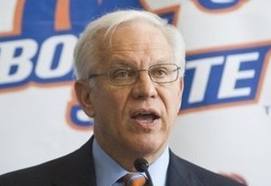
Boise State University is getting hit with a “double whammy” on funding, and on Monday, university president Bob Kustra appealed to legislative budget-writers for help.
Appearing before the Joint Finance-Appropriations Committee, Kustra waded through the complicated — and longstanding — issue of funding equity for the state’s universities. If funding equity is left unaddressed, Kustra said, BSU students may be forced to spend more time, and money, completing their studies.
Funding equity is known officially as Enrollment Workload Adjustment, or EWA. The objective is to fund universities’ enrollment growth, factoring in the cost differences between university programs. For Boise State, the issue boils down to two numbers:
- The big one is $4.96 million.
The Legislature’s Office of Performance Evaluations studied the funding equity issue last summer. In response, the State Board of Education recommended $4.96 million for BSU. That wouldn’t entirely bridge the gap for BSU, calculated at more than $10.3 million.
Gov. Butch Otter’s budget proposal does not include money for funding equity, even at the reduced level sought by the State Board. Read Kevin Richert’s blog about what the governor’s office has to say.
- The smaller number is $88,000.
The Otter budget does include equity funding for 2013-14 – but BSU actually would take a slight hit. That’s because the equity formula uses a three-year enrollment average, and BSU’s enrollment took a hit in 2011 with the advent of the College of Western Idaho. Some 1,200 professional-technical students were moved under CWI’s umbrella, when their programs were transferred from BSU to the fledgling two-year college, and other students transferred to CWI on their own.
BSU fully expected the enrollment shift to CWI, said Kustra, but didn’t expect this shift to cost BSU funding three years after the fact. Kustra appealed to JFAC members to remember that BSU has made an “incredible investment” in support of the launch of CWI, and address the equity issue accordingly.
If the state provides equity funding, Kustra says BSU would use the money to help undergraduate students take courses in their majors. Students too often hit a “bottleneck” by their junior year, as they shift from introductory classes to coursework in their major. If students cannot get into these classes in a timely manner, they may not be able to receive a degree in four years.
After his JFAC presentation, Kustra said he believes the equity issue will be resolved.
“Everybody’s trying to search for the solution right now, and there’s plenty of time to do that.”
Idaho State University
Monday marked the start of “Education Week” at JFAC, as budget-writers hear presentations from university and college presidents and state schools superintendent Tom Luna.
Idaho State University President Arthur Vailas addressed JFAC Monday – and said he endorsed Otter’s proposal to fund five additional Idaho seats at the University of Washington’s medical school.
Vailas has long advocated increased medical programs in Idaho, and said Idaho must still address its long-term needs. Funding the additional medical school seats at University of Washington is a short-term move, but still represents a “good step forward” for the state.
(Disclosure: Idaho Education News is housed under the Center for School Improvement and Policy Studies in Boise State University’s College of Education. Its staff members are BSU employees.)
